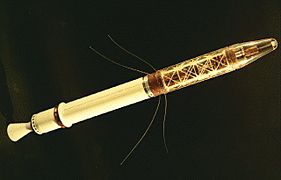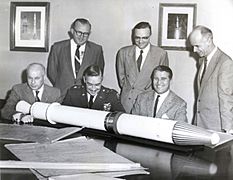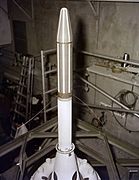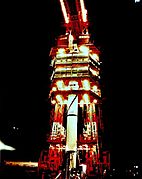Explorer 1 facts for kids
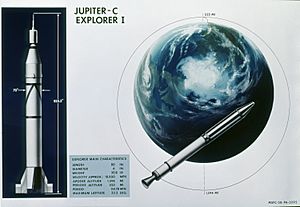
Explorer 1 statistics and orbital diagram
|
|
| Names | Explorer I 1958 Alpha 1 |
|---|---|
| Mission type | Earth science |
| Operator | JPL / Army Ballistic Missile Agency |
| Harvard designation | 1958 Alpha 1 |
| Mission duration | 120 days (planned) 111 days (achieved) |
| Spacecraft properties | |
| Spacecraft | Explorer I |
| Spacecraft type | Science Explorer |
| Bus | Explorer 1 |
| Manufacturer | Jet Propulsion Laboratory |
| Launch mass | 13.97 kg (30.8 lb) |
| Dimensions | 203 cm (80 in) length 15.2 cm (6.0 in) diameter |
| Power | 60 watts |
| Start of mission | |
| Launch date | 1 February 1958, 03:47:56 GMT |
| Rocket | Juno I (RS-29) |
| Launch site | Atlantic Missile Range, LC-26A |
| Contractor | Army Ballistic Missile Agency |
| Entered service | 1 February 1958 |
| End of mission | |
| Last contact | 23 May 1958 |
| Decay date | 31 March 1970 |
| Orbital parameters | |
| Reference system | Geocentric orbit |
| Regime | Medium Earth orbit |
| Perigee | 358 km (222 mi) |
| Apogee | 2,550 km (1,580 mi) |
| Inclination | 33.24° |
| Period | 114.80 minutes |
| Revolution no. | 58402 |
|
Explorer program
|
|
Explorer 1 was the very first satellite launched by the United States. It blasted off in 1958. This mission was part of the U.S. efforts during the International Geophysical Year (IGY).
Before Explorer 1, the Soviet Union had already launched two satellites: Sputnik 1 and Sputnik 2. This started the "Space Race" between the U.S. and the Soviet Union. It was a friendly but intense competition to see who could achieve more in space.
Explorer 1 launched on February 1, 1958, from Cape Canaveral in Florida. It rode into space on a Juno I rocket. This satellite made a huge discovery: it found the Van Allen radiation belt. This is a zone of charged particles trapped around Earth. Explorer 1 sent back data for almost four months. It stayed in orbit for over 12 years, finally falling back to Earth in 1970.
Contents
Why Explorer 1 Was Launched
The idea for a U.S. Earth satellite began in 1954. It was a joint plan by the U.S. Army and U.S. Navy. They wanted to put a scientific satellite into orbit during the International Geophysical Year. This project was called Project Orbiter.
However, in 1955, the U.S. government chose a different plan. They picked the Navy's Project Vanguard. This project used a rocket that seemed more peaceful. But then, the Soviet Union launched Sputnik 1 in October 1957. This surprised everyone.
To catch up, the U.S. quickly restarted the old Project Orbiter. It was renamed the Explorer program.
Building Explorer 1
The Jet Propulsion Laboratory (JPL) designed and built Explorer 1. The Army Ballistic Missile Agency (ABMA) modified a Jupiter-C rocket to carry the satellite. This new rocket was called the Juno I.
The Jupiter-C rocket had already been tested. It was used for tests of missile nose cones returning to Earth. Working together, ABMA and JPL finished Explorer 1 and its rocket in just 84 days.
But before they were done, the Soviet Union launched Sputnik 2 in November 1957. Then, the U.S. Navy's first attempt to launch a satellite, Vanguard TV-3, failed in December 1957. This made the success of Explorer 1 even more important.
How Explorer 1 Was Designed
Explorer 1 was built by JPL under the lead of Dr. William Hayward Pickering. It was the second satellite ever to carry scientific tools into space.
The satellite weighed about 14 kilograms (31 pounds). About 8.3 kg (18 pounds) of this was for its scientific instruments. To compare, the Soviet Sputnik 1 weighed 83.6 kg (184 pounds).
The front part of the satellite held the instruments. The empty last stage of the rocket stayed attached. They both spun together at 750 rotations per minute. This helped keep the satellite stable.
Sending Data to Earth
Explorer 1 had two antennas to send data back to Earth. One was a small antenna that sent signals at 108.03 MHz. The other was made of four flexible whips. It sent signals at 108.00 MHz.
The satellite's electronics used transistors. These were new and very small for the time. This helped keep the satellite light. Power came from mercury batteries. These batteries made up about 40% of the satellite's weight.
The outside of the instrument section was made of stainless steel. It had white stripes. These stripes helped control the satellite's temperature in space.
What Explorer 1 Carried
The scientific tools on Explorer 1 were designed by Dr. James Van Allen from the University of Iowa. They included:
- Cosmic Ray Detector: This was a Geiger–Müller tube. It was designed to find cosmic rays. Cosmic rays are high-energy particles from space. This tool often got overloaded by strong radiation.
- Temperature Sensors: There were five of these. They measured the temperature inside and outside the satellite.
- Micrometeorite Detectors: These tools looked for tiny space dust impacts.
- An acoustic detector listened for impacts on the satellite's skin.
- A wire grid detector had thin wires. If a tiny dust particle hit and broke a wire, it would record the event.
Explorer 1 did not have a tape recorder to save data. So, scientists only got data when the satellite passed over ground stations. This made the early data puzzling. Later, Explorer 3 had a tape recorder. It helped confirm the amazing discovery made by Explorer 1.
The Flight and Its End
After a short delay due to bad weather, the Juno I rocket launched on February 1, 1958. Explorer 1 successfully entered orbit. It flew as close as 358 kilometers (222 miles) to Earth. It went as far as 2,550 kilometers (1,580 miles) away. Each trip around Earth took about 115 minutes.
At first, scientists thought the satellite would last for three years. The powerful transmitter worked for 31 days. The weaker transmitter worked for 105 days. Explorer 1 stopped sending data on May 23, 1958, when its batteries died.
But the satellite itself kept orbiting for over 12 years! It finally reentered Earth's atmosphere over the Pacific Ocean on March 31, 1970. It had completed more than 58,400 orbits.
Amazing Discoveries
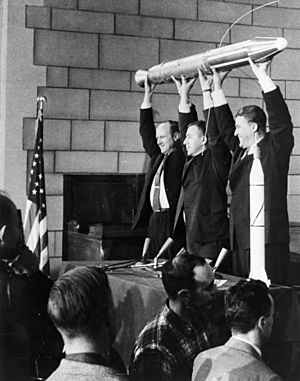
After launch, Explorer 1 started spinning in an unexpected way. It was supposed to spin smoothly along its longest axis. But it started wobbling instead. Scientists later figured out why. This helped them understand how objects move in space.
The most important discovery was about cosmic rays. Sometimes, the cosmic ray detector showed normal counts. But other times, it showed zero counts. Dr. James Van Allen and his team noticed something. The zero counts happened when the satellite was very high up, over 2,000 kilometers (1,240 miles). At lower altitudes, the counts were normal.
They realized the detector was not broken. Instead, it was being overwhelmed! It was hit by so much radiation that it couldn't count anymore. This strong radiation came from a belt of charged particles trapped by Earth's magnetic field. This discovery led to the naming of the Van Allen radiation belt. This was one of the greatest discoveries of the International Geophysical Year.
The micrometeorite detector also found interesting things. It recorded 145 impacts from tiny space dust particles. This showed how often small objects hit spacecraft in orbit.
Explorer 1's Lasting Impact
Explorer 1 was the first of many satellites in the Explorer program. This program continued to launch many successful science missions. After Explorer 1, four more Explorer satellites were launched in 1958. Explorer 3 and 4 were successful.
A new version of the satellite, called Explorer-1 [PRIME], was launched in 2011. It was built using modern technology.
You can see a copy of Explorer 1 in the Smithsonian Institution's National Air and Space Museum in Washington, D.C. There's also a model on display at the Air Force Space and Missile Museum in Florida, at the old launch site.
Gallery
-
Officials with Explorer 1 model at Redstone Arsenal, including Maj. Gen. John Medaris (3rd from left), Walter Haeussermann, Wernher von Braun and Ernst Stuhlinger
-
Preliminary satellite tracking tests in a field near JPL
See also
 In Spanish: Explorer 1 para niños
In Spanish: Explorer 1 para niños




